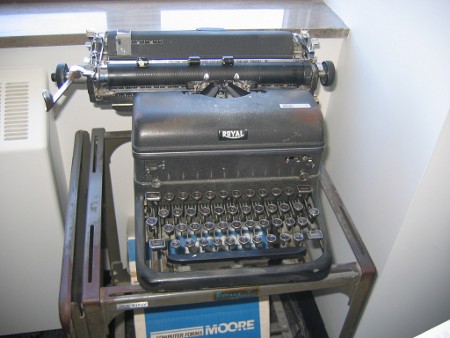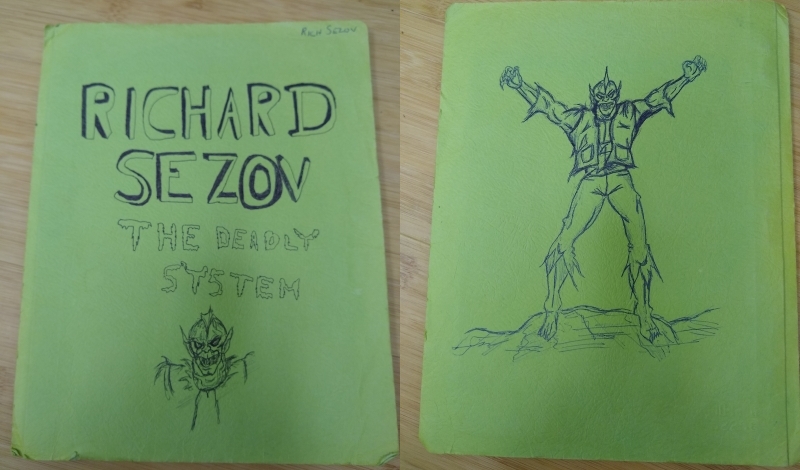Published: Apr 27, 2021 by Richard Sezov
Some writers prefer writing their novels out longhand, in notebooks. I’ve never understood people who prefer writing on pen and paper. Maybe I’m weird, but the idea of doing any serious writing by pen—and then having to type it later—has never worked for me. I suppose that means I was born at the right time.
I started taking writing seriously at about 12 years of age. At this point, that’s a long time ago, since I was 12 years old in the 80s. Since then, a lot of things have changed with regard to writing: word usage (I still by default write worshipped and kidnapped), the process (mindmapping replaces outlining for me), and most especially the tools (pen/pencil and paper, to typewriter, to text-based computer, to graphical computer).
I was bad at penmanship in grammar school. It was the only subject in which I got Cs and Ds consistently. I struggled through capital letters, chafed through lower case letters, and dragged on cursive. Finally, in the 5th grade, when penmanship was no longer a course, I switched myself to writing in all caps and have stuck with that until now. Why? Because the nature of capital letters means you have to slow down and be more careful, thus producing more legible text. And by the 5th grade, none of my teachers cared about it, as long as they could read my assignments.
We used to have these spelling assignments where you’d get a list of new words to spell and you had to make up sentences containing those words. Rather than produce a bunch of dry, boring sentences (e.g., “The patient was paralyzed from the waist down”), I’d make up stories and work the spelling words into these. My teachers loved it. I always got an A+ on my spelling sentences—when my teachers could read them. I still have some of these stories in a trunk in my basement.
Somewhere around this time, I got a plastic “children’s” typewriter. I think it was only labeled a children’s typewriter because it was cheap plastic: it did have metal hammers and a real ribbon. My mom, who was an office manager for an orthopedic surgeon, was an excellent touch-typist, and she taught me to type. At this point in my life, though, I didn’t have much use for the skill, because I couldn’t use it for my school work, and I hadn’t gotten the idea yet that I might someday become a writer. Handwriting was everything in school work at this time, and I sucked at it.
I was always a creative kid. I attempted a magazine based on Mad Magazine which I called Crazy Magazine. Of course, my drawing skills are probably worse than my penmanship skills, so the magazine really had no prayer of going anywhere—but I do remember photocopying several issues and handing them out at school.
Also about this time, friends whose families had more money than mine began getting Commodore 64, Atari, and Apple II computers. I was incredibly interested in these things, but they were way out of reach for my single mom to purchase. I remember the envy I felt in 8th grade when we had these bulletin board projects to do and my friends were able to produce posters and banners strung together on dot-matrix paper, while I was stuck with crappy construction paper, markers, and bad drawing skills.
 I don’t remember what circumstances brought this about—it was probably getting older and having to start writing papers for school—but in the 7th or 8th grade, my stepfather pulled out for me this old Royal manual typewriter. The thing must’ve weighed 50 pounds. It was gun metal gray and had round keys that when you pressed them, went way, way down, slapping a hammer through an inked ribbon onto a page. Near the end of each line a bell would ring, signifying that you needed to finish the word you were working on or hyphenate it. Once you did this, you’d reach up with your left hand and in a smooth motion that my mother demonstrated for me, use a bright, chrome lever to swipe the platen, or the roller the paper was on, back over to the right to begin a new line. I looked at the machine in awe. Everything about it said to me, “serious writing.”
I don’t remember what circumstances brought this about—it was probably getting older and having to start writing papers for school—but in the 7th or 8th grade, my stepfather pulled out for me this old Royal manual typewriter. The thing must’ve weighed 50 pounds. It was gun metal gray and had round keys that when you pressed them, went way, way down, slapping a hammer through an inked ribbon onto a page. Near the end of each line a bell would ring, signifying that you needed to finish the word you were working on or hyphenate it. Once you did this, you’d reach up with your left hand and in a smooth motion that my mother demonstrated for me, use a bright, chrome lever to swipe the platen, or the roller the paper was on, back over to the right to begin a new line. I looked at the machine in awe. Everything about it said to me, “serious writing.”
Coincidentally, a short time before this typewriter appeared, I’d done some of my first bit of creative writing outside of my spelling sentences, just for fun. I’d written a science fiction story called “The Illusionists” that had been inspired by a dream I’d had. The story had some promise, I thought, if other people could read it. Now that I had the typewriter, I thought maybe I could try my hand at another one—and this time, I’d type it. I was a freshman in high school by now and taking a typing class, so if the story stank, at least I’d become a faster typist. And so I produced a story called “The Deadly System,” also loosely based on a dream I’d had (I had probably seen Alien recently; it bears some similarities). I stuck this one in a green folder and gave it to a friend of mine—a budding artist as I was a budding writer—to read. The story inspired him enough to illustrate the front and back of the green folder with the monster in the story, which I thought was pretty cool. There are more details here, but they aren’t germane to my point.

I was off and running. That story blossomed into several more, some of which got published in my high school’s literary journal. Soon I began thinking that I might want to do this writing thing for a living. Now I was doing serious writing, and that writing always happened at a keyboard.
I had a love/hate relationship with my typewriter. I loved typing, and I got quite good at it. I could get my thoughts down a lot faster—not to mention more legibly—if I typed them rather than writing them with a pen. It was too easy, however, to hit the wrong key, which immediately made the sheet of paper you were working on imperfect. But I kept slugging away, even beginning a novel (the rewrite of which, incidentally, may be my next novel).
I got really serious about computers in high school, mostly because of my interest in writing. Writing on a computer removed all the barriers put in place by a typewriter—typing mistakes, messy ribbons, keys getting stuck, loading another sheet of paper in the middle of a thought, and more. On a computer, you never had to re-type anything to revise it; you just made the change right there, on the screen. It was like magic. Kids these days have no idea what we went through with typewriters.
Upon my high school graduation, I got a PC—a discounted Philips with an amber, monochrome screen—to take to college with me, where I would be majoring in English. It had an 8088 processor. The 386 had just come out, so my new machine was already antiquated, but I loved the thing. I did all of my college writing on that PC, in WordStar, where I most appreciated being able to continuously type without having to reach up and swing that platen over at the end of every line. And of course, there was the all-important Backspace key, allowing me to correct mistakes on the fly.
The point I want to make here is that for me, the keyboard has always represented serious writing—whether that writing is creative, scholarly, or technical. Writing with a pen always got in my way and represented extra, tedious work—in other words, re-typing, not to mention deciphering what I wrote—and there are far better ways to use my time. I’m happy to write notes in a journal and jot lists, but if I want to do any serious writing, I always sit down at a keyboard. I’ll probably never understand people who have this affinity for paper and pen. There are now better tools.